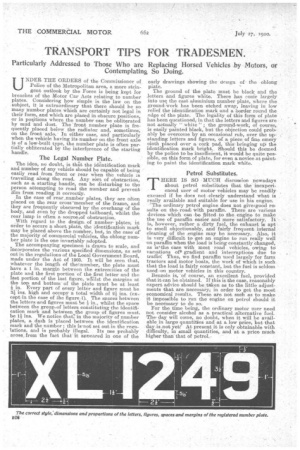TRANSPORT TIPS FOR TRADESMEN.
Page 24

If you've noticed an error in this article please click here to report it so we can fix it.
Particularly Addressed to Those Who are Replacing Horsed Vehicles by Motors, or Contemplating So Doing.
UNDER THE ORDERS of the Commissioner of Police of the Metropolitan area, a more stringent outlook by the Force is being kept for breaches of the Motor Car Acts relating to number plates. Considering how simple is the law on the subject, it is extraordinary that there should be so many number plates Which are certainly not legal in their form, and which are planed in obscure positions, or in pokitions where the number can be obliterated by mud and dust. The front number plate is frequently placed below the radiator and, sometimea, on the front axle. In either case, and particularly when the vehicle having its-number on the front axle is of a low-built type, the number plate is often partially obliterated by the interference of the starting handle.
The Legal Number Plate. •
The idea, no doubt, is that the idLtification mark and number of any vehicle should be capable of being easily read from front or rear when the vehicle is travelling along the road. Any sort of obstruction, such as a starting handle can be disturbing to the person attempting to read the number and prevent him from reading it correctly. In the case of rear .number plates, they are often placed on the rear cross`member of the frame, and they are frequently obscured by the overhang gf the body, and even by the dropped tailboard, whilst the rear lamp is often a soureeof obstruction. With regard to the design: of numberplates, in order to secure a short plate, the identification mark may be placed above the number, but, in the case or the majority of commercial vehicles, the oblong number plate is the one invariably adopted. The accompanying specimen is drawn to Beak, and incorporates the various specified dimensions, as setf out in the regulations of the Local Government Board, made under the Act of 1903. It will be seen that, whatever the length of thecnumber, the plate must have a 1 in. margin between the extremities of the plate and the first portion of the first letter and the last portion of the last figure, whilst the margins at the top and bottom ' of the plate must be at least i. in. Every part of every letter and figure must be 3i ins, high and occupy a total width of 0, ins. (except in the ease of the figure -1). The spaces between the letters and figures must be 1 in., whilst the space between the group.of letters constituting the identification mark and between the group of figures must. be li ins. We notice thee,' in the majority of number plates, a dash is placed between the identification mark and the number ; this itenot set out in the regulations, and is probably illegal. Its use probably arose, from the fact that it appeared in one of the early drawings showing the design of the oblong plate. The ground of the plate must be black and the letters and figures white. There -has conic largely into use the cast aluininium number plate, where the ground-work has been etched away, leaving in low relief the identification mark and a border round the, edge of the plate. The legality of this form of plate has been questioned,in that the letters and figures are • not actually " white " ; the ground-work, of course, is easily painted black, but the objection could probably be overcome by an occasional rub, over the upstanding letters and figures, of a piece -of fine emery cloth placed over a cork pad, this bringing up the identification mark bright.. Should this be deemed by the police to be insufficient, it would be quite possible, on this farm of plate, for even a novice at painting to paint the identification mark white.
Petrol Substitutes.
THERE IS SO MUCFI, discussion nowadays about petrol substitutes that the inexperienced user of motor vehicles may be readily excused if he does note clearly understand what is really available and suitable for use in his engine. 'The ordinary petrol engine does not giveagood results on the, roach With paraffin. There are various devicea which can -be fitted to the engine to make the use of paraffin easier and more satisfactory. It is, however, rather a dirty fuel, the exhaust is apt to smell objectionably,' and fairly frequent internal cleaning of the ,engine may be necessary. Also, it is very difficult to get an engine to run really well 'on paraffin when the load is' being constantly changed, as is'-the case with most read vehicles, owing to variations of gradient and interruptions due to traffic': Thus, we find paraffin used largely for farm tractors and motor beats the work of which is such that the load is fairly ean4ant, but the fuel is seldom used-on motor vehicles in this country. Benaole is, of course, an excellent fuel, provided that it can be obtained. If this is the case, reasonably expert adyke should be taken as to the little adjustments that are necessary; in order toget the most economical results. These are not such as to make it impossible to run the engine on petrol should it be. necessary to do so. For the time being, the ordinary motor user need not consider alcohol as a practical ,alternative fuel. The day will come, no doubt, when it will be available in large quantities and at a low price, but that day is not yet e' At present it is only obtainable with difficulty, in small quantities, and at a price much higher thaa that of petrol.,




























